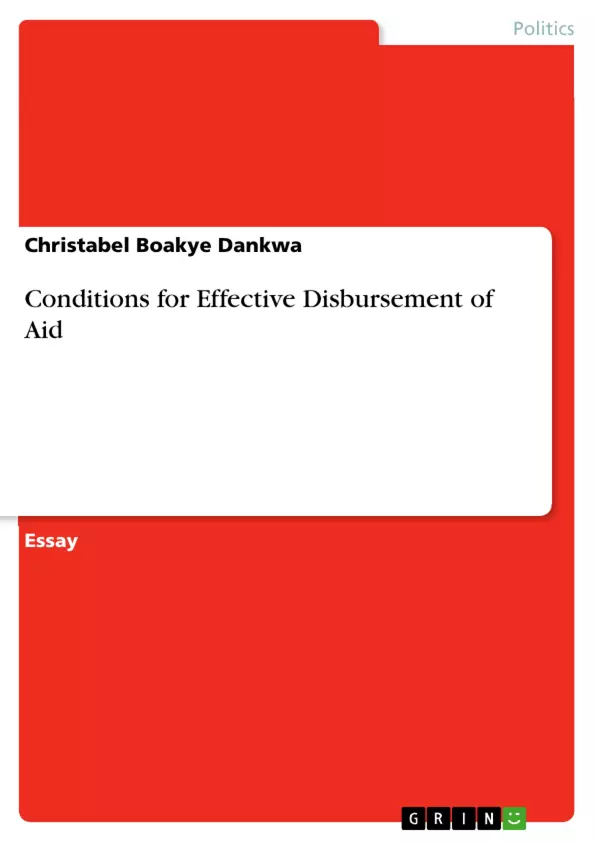In the past, countries developed at their own pace without assistance from other countries. However, with the growing disparities between the developed and the least developed countries it has become imperative for the ‘have’ to assist the ‘have not’ to bridge the yawning gap in the levels of human development around the world but the disbursement of aid has become a major challenge.
This paper tries to find out how aid can be delivered effectively to help to achieve sustainable development in recipient countries. The first part tries to explain what constitute aid by various authorities on the subject, the types and origin of aid. The second part identifies the various posits in the aid debate. The third section stipulates some of the conditions necessary for aid disbursement to be effective. The final part makes up the conclusion.
Inhaltsverzeichnis (Table of Contents)
- INTRODUCTION
- WHAT IS AID?
- Types of Aid
- Historical Overview of Aid
- Purpose of aid
- THE AID DEBATE
- INTERNATIONAL CONFERENCES ON AID EFFECTIVENESS
- CONDITIONS FOR EFFECTIVE AID DISBURSEMENT
- CONCLUSION
Zielsetzung und Themenschwerpunkte (Objectives and Key Themes)
This paper explores the complexities of aid disbursement and its effectiveness in achieving sustainable development. The study aims to unpack the concept of aid, examine the ongoing debate surrounding its impact, and identify critical conditions for successful aid delivery.
- Defining and classifying aid, including its historical context
- Evaluating the effectiveness of aid and the various perspectives within the aid debate
- Identifying factors influencing aid effectiveness and the role of political and economic interests
- Examining the impact of aid on recipient countries' development trajectories
- Exploring potential strategies to enhance aid disbursement effectiveness and achieve sustainable development outcomes
Zusammenfassung der Kapitel (Chapter Summaries)
The paper begins by defining aid, outlining its types and historical evolution. It traces the concept back to the 19th and 20th centuries, where European powers provided financial support to their colonies for economic development. The paper also highlights the emergence of aid as a key element in post-World War II reconstruction efforts and the evolving role of aid during the Cold War.
Following this overview, the paper delves into the ongoing debate surrounding aid effectiveness, exploring both the proponents and critics of aid. Proponents argue that aid can be a crucial catalyst for development, especially when disbursed strategically and channeled toward practical interventions. Critics, however, emphasize the complexities of aid disbursement, highlighting issues such as corruption, inefficient implementation, and political interests that can undermine its effectiveness.
The paper explores various factors influencing aid effectiveness, including recipient country governance, institutional capacity, and the alignment of aid with national development priorities. It examines the potential challenges of conditionality and its impact on recipient countries' autonomy.
Schlüsselwörter (Keywords)
The central themes of this paper revolve around aid, development, aid effectiveness, and aid disbursement. The paper explores the complexities of aid delivery, the challenges and opportunities of international development assistance, and the diverse perspectives on aid effectiveness. It analyzes the impact of aid on recipient countries and identifies crucial factors that influence its success.
- Quote paper
- Msc.Development Studies Christabel Boakye Dankwa (Author), 2014, Conditions for Effective Disbursement of Aid, Munich, GRIN Verlag, https://www.hausarbeiten.de/document/284241


